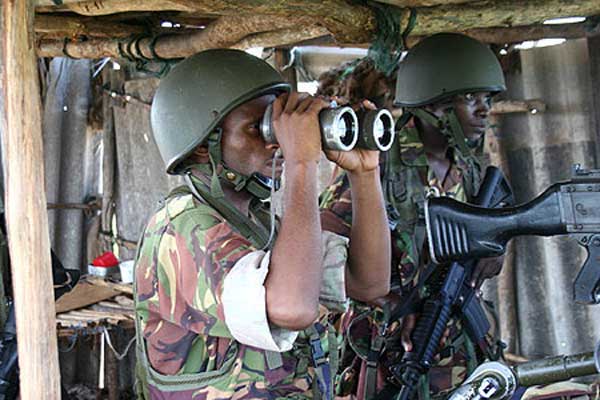
“To the people who live in North Eastern region (Somalis), I have this to say: We know that many of you are herdsmen during the day and shiftas (bandits) at night” remains the most infamous statement from the then Prime Minister Jomo Kenyatta, in his address to Parliament in 1964.
“Kaeni hivyo hivyo na Mungu awabariki’ was his successor Daniel arap Moi’s sign off signature whenever he addressed a rally in North Eastern province, a statement understood by locals to mean the destiny of the people there will never change. True to the retired President’s word, things have not changed much in almost all spheres of life, half a century after the country attained self-rule.
In the present day war on terror, they are the ‘enemy within’, the ‘al-Shabaab sympathiser’, the ‘Godane buddy’ and refugees. (Ahmed Abdi) Godane is the head of the Somalia-based al Shabaab insurgents.
Analysts say even as al Shabaab mutates to a multinational and multiracial outfit, Somalis still represent the ‘head and the tail’.
As the late Internal Security assistant minister Orwa Ojode succinctly put it, the government is “fighting a snake that has its head in Nairobi” referring to the large Somali community that mainly inhabits Kenya’s ‘Small Mogadishu’, Eastleigh.
By most accounts, they are the worst victims of unequal development, dating back to colonial times. This is the sad tale of the Kenyan-Somalis, a tale punctuated by an ugly ethnic stereotyping, massive youth unemployment, chronic poverty and disenfranchisement.
Today, 50 years later, they are being hounded as suspected terrorists and flocked to Safaricom Stadium Kasarani, a place human rights activists say is reminiscent of a concentration camp.
It started on April 2 when the police began arresting people of Somali origin in Eastleigh and confined them in Kasarani stadium, following a blast in the area on March 31 which killed six people. Among the dead were two Somalis.
Many of those arrested were Kenyans with valid documents. They were released after ‘buying’ their freedom.
“As the country marks a year since the swearing in of President Uhuru Kenyatta, the venue of his inauguration – Kasarani Stadium – has been playing host to thousands of almost exclusively ethnic Somalis who have been arrested for not producing proper identification documents,” said Patrick Gathara, a strategic communications consultant based in Nairobi in Al Jazeera website.
“For the last half-century, Kenyan authorities have treated Muslims and ethnic Somalis with suspicion, seeing them at best as just short of being Kenyan and at worst as a fifth column — the enemy within. In colonial times, their status as native Africans was at best ambiguous and in the run-up to independence, a push towards greater autonomy at the coast and the desire of the Somali population in then Northern Frontier District to join Somalia, heightened perceptions of these communities as traitors to the Kenyan cause,” he added.
According to an essay by Prof Jeremy Prestholdt of the Department of History at the University of California, San Diego titled “Kenya, the United States,and Counter-terrorism, “the government of Kenya’s anti-terrorism initiatives have compounded an already deep sense of alienation among those most severely affected by the new measures: Kenyan Muslims, particularly those of Arab and Somali ancestry.”
In the ongoing crackdown on suspected illegal immigrants, the Human Rights Watch says “hundreds of detainees (are) packed into cells designed to accommodate 20 people” at Pangani police station in Eastleigh,.
“Detainees had no room to sit, and the cells were filthy with urine and excrement. Police were also holding detainees beyond the 24-hour limit proscribed under Kenyan law, without taking them to court. One man at Pangani station complained to Human Rights Watch that he had been held for eight days without being taken to court,” said the New York-based global rights body.
Somalis are arguably the fifth largest community in Kenya and the largest tribe among all of the country’s Cushitic tribes, living in North-Eastern region, formerly known as the Northern Frontier District.
Other Cushitic tribes include the Rendile, Borana, Gabra and the Galla communities of Eastern Kenya.
The colonial government had imposed a deliberate policy to isolate and exclude this expansive area from the rest of the country. And as Kenya marked the year of Jubilee, commentators say, Somalis still fight for recognition and equal rights, making them feel like “outsiders in their own home”.
“I was born in this country, schooled but due to this ethnic labelling, I now feel that I am a lesser Kenyan” is a sad cry Kenyan-Somalis have to endure despite being in the heart of the country’s administration.
Even with their growing clout, and Somali professionals increasingly appointed to important government positions, their patriotism is still ‘misplaced’ and often ‘questioned’.
In the advent of increased terror-related attacks, ‘draconian’ crackdown on Kenyan Somalis has been on the rise. Any reported or perceived threat to national security will lead to automatic detention. When gunmen attacked the Westgate Mall in September last year, killing 67 people died and leaving scores of others injured, fears of reprisal attacks were real.
Muslims for Human Rights Forum executive director Al-Amin Kimathi said this is despite no Somali has ever been successfully prosecuted and convicted.
Mohamed Jaylani Mohamed, who was later acquitted by Chief Magistrate Kiarie Waweru in a Nairobi court in May this year, for lack of evidence, remains the only Somali ever charged in a Kenyan court of law.
Mohamed was accused of hurling a grenade at Buffalo Guest House in Eastleigh injuring two people, Julias Mulira and Meitiake Ole Salash.
Elgiva Bwire Oliacha, a non-Somali was sentenced to life imprisonment in October 2011, after he pleaded guilty to taking part in two grenade attacks in Nairobi and confessed that he was a member of al Shabaab terror group.
In November last year, after an explosion rocked Kariobangi-bound matatu that left 10 people dead, gangs of young people from Eastleigh neighbourhoods took to the streets, attacking residents of Somali origin and looted Somali-owned businesses.
Ahmed Abdi, a Kenyan Somali from Wajir County, was almost lynched by the roadside by an angry mob ‘for being behind the attack’.
Ahmed was in the ill-fated mini-bus when the explosion ripped off the matatu. He was later chained to his Kenyatta National Hospital bed for hours by the police as ‘a suspect’.
“I was handcuffed to bed for hours with cameras focusing on me as a suspect,” said a distraught Ahmed, whose right leg has since been amputated following the blast.
A Kenyan-Somali military officer who has recently returned from Somalia (name withheld) expressed anger how they were called ‘infidels’ by al Shabaab in Somalia for fighting alongside the ‘enemy’ (KDF) while his “fellow Kenyan-Somalis are branded al Shabaab sympathisers at home”.
“It is painful when some of us are ready to die for this country, while others are looking at us with the ‘enemy within’ mindset,” he said.
In 2012, following the killing of three Kenyan soldiers by unknown gunmen in Garissa, soldiers invaded a famous market, Suq Mugdi (The dark market), and set it ablaze, bringing the economic lifeline of thousands of traders to a standstill. “It was a case of burning the house to kill the rats. No one was held accountable until now,” said Moulid Hassan of Garissa.
Ojode’s statement in Parliament after a grenade attack in Eastleigh was then dismissed as ‘irresponsible’ and with the ability to raise serious xenophobic reprisals. “This is like a big animal with the tail in Somalia and the head in Eastleigh,” he said.
That statement is believed to have led what the New York-based Human Rights Watch reported as widespread human rights abuses against ethnic Somalis in a ’10 weeks of hell’.
“Rather than conducting investigations to identify and apprehend the perpetrators, both the police and army responded with violent reprisals against Kenyan citizens and Somali refugees,” said Leslie Lefkow, the deputy Africa director at Human Rights Watch.
A report by the Kenya National Human Rights Commission in 2007, ‘An Identity Crisis? A Study on the Issuance of National Identity Cards in Kenya’ painted a grim picture of how ‘xenophobic attitude displayed by the Kenyan government against Somalis in general is a major factor fuelling bitterness that the state does not care about them’.
“The people from this region feel that they are exiles in their own country as the process of vetting and registration denies Kenyan-Somalis equal access to registration and acquisition of National IDs,” said the report.
The report further says applicants of Somali origin have to go through a painstaking vetting committee, a requirement that other ethnic groups living in the same area are not subjected to on account “of the difficulties of distinguishing a Kenyan-Somali from a Somali from Somalia”.
The issuance of identity cards does not spare students who are forced to go back to ‘their rural areas’ to get the most important document.
The profiling of Kenyan Somalis from the North Eastern by security forces in the guise of stopping aliens from entering the country is an issue that is retold over and over again.
This started immediately after independence with local Somali population being forced to produce a permit (kipande) before being allowed to move to the other parts of the country.
This was inherited by successive regimes and the Tana River police post is one of the most dreaded check points manned by officers who would even doubt the documents of government officials.
A trip from Mandera to Garissa, that is by all standards a nerve-wracking ride, is made worse by the more than 20 check points where identification documents are demanded.
At the Tana River Bridge check point, scenes of long queues of people frisked and documents scrutinised is common and while this can pass of as a normal security procedure, ‘there is more than meets the eye’.
“The local police officers intimidate everyone including those with genuine documents and at times forcing people to speak in Kiswahili and considering the poor education standards many may not be in position to speak Kiswahili and end up being detained and branded ‘an alien’,” Mohamed said.
According to Salah Abdi Sheikh, a social commentator, the national identity card which proves the citizenship of a holder is still a discriminatory document when it comes to Somalis.
“An extra vetting and documentation is necessary for Somalis which are not necessary for the Maasai who live both in Kenya and Tanzania, the Teso who are a minority in Kenya but are the second largest African tribe in Uganda, the Samia who traverse the Kenya-Uganda border and the Kenyan whites who immigrated here at the turn of the century,” he said.
He noted that Somalis are even accused of all sorts of evils from having affiliation to terrorists to increasing the cost of living in the country.
“There are two million Somalis in Kenya and hardly one per cent is involved in all the reported issues. The rest live under the same insecurity and poverty pervading this country,” said Salah, who is also the author of ‘Blood on the run-way: Wagalla Massacre of 1984’.
In her report ‘ Rendering Difference Visible: The Kenyan State and its Somali Citizens’, Emma Lochery, a Portuguese researcher, said the ‘the Kenyan state has institutionalised the marginality of its Somali citizens’. “Due to the way the Kenyan nation state has been constructed and negotiated since colonial times, some groups have more rights and protections than others. Somalis……… are lower down the citizenship ladder and more vulnerable to persecution and neglect by state institutions,” said Emma.
‘Thorny relations’ between Somalis in Kenya and those of other groups date back to independence in 1963. Somalis in the NFD vigorously sought to join ‘their kin’ in the Somali Republic to the north, leading to the Kenyan government enacting a number of repressive measures designed to frustrate their efforts in what came to be known as the Shifta War (1963–1967).
This was a secessionist conflict in which ethnic Somalis in the NFD attempted to join with the other Somalis in the neighbouring Somalia.
The war christened ‘shifta war’ is still remembered among the people of North Eastern as the government implemented punitive collective punishment on the population irrespective of being combatant or non- combatant.
Rhythmic movement of pastoral life was stopped; a time when man and beast were detained together in concentration camps. Livestock herds killed and formerly wealthy pastoralists left paupers. British anthropologist Alex de Waal described the consequence as a military assault upon the entire pastoral way of life.
In February 10, 1984 and in what the United Nations said represents the worst human rights violation in Kenya’s history, about 5,000 people were killed in a village called Wagalla, 15km west of Wajir town.
Kenyan troops had descended on villages, rounded up men before being ferried in lorries to a small airstrip. They were later brutally executed leaving widows and orphans behind.
In 1980, a similar incident happened in Garissa when armed forces invaded villages, reportedly raped women and burnt down their homes in retaliation for the deaths of three government officials in what was later known as the Garissa Gubay (The burning of Garissa).
There are similar stories of incarcerations in the region in the name of “security operations”. The Bulla Karatasi of Garissa in 1980 and Malka Mari of Mandera are some of the worst blood-letting inflicted on the people there.
In a bid to shield soldiers from civil or criminal liability during this war, the infamous Indemnity Act was enacted. The Act barred victims of this war from seeking legal redress and compensation.
The Kenyan government was also accused of mass slaughters of entire villages of Somali citizens and their animals and setting up concentration camps, meant to deal with the ‘shifta’ problem.
“Somalis of Kenya have suffered triple jeopardy since independence; they are nomadic pastoralists stuck in the medieval times, they are Muslims now associated with extremist ideas and they are Africans suffering from the same ineptitude of their leaders,” said Salah.
Are Somalis the enemy within or victims of ethnic profiling









